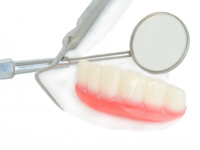New Tooth Tattoos Could Help To Prevent Gum Disease

A new tooth tattoo developed by scientists at Princeton University and Tufts University could help to prevent gum disease.
The tooth tattoo, which was designed and constructed by nanoscientist, Michael McAlpine and bioengineers from Tufts University, Fiorenzo Omenetto, Hu Tao and David Kaplan, contains a sensor, which measures the levels of bacteria in the mouth; the sensor is made from gold, graphite and silk.
By measuring the levels of bacteria in the mouth, the sensors can indicate when a patient is at risk of developing gum disease. The sensors could also predict the risk of other diseases which can be identified by analysing the saliva, such as AIDS and stomach ulcers.
The tooth tattoo is fairly simple in design; the sensor is made from a thin layer of gold, a layer of graphene and a peptide, with a layer of silk supporting the entire structure. The silk layer is designed to dissolve once the tattoo is pressed onto the surface of the tooth and once the sensor is in place, it will be powered wirelessly.
The tooth tattoo has not yet been tested on human teeth but trials on cow teeth have been positive. The challenge would be making the tattoo thin enough to ensure that the patient would not experience any difficulties or discomfort from it. Large animals, like cows, are also less likely to bother about having foreign objects in their mouth.
Join this Discussion









